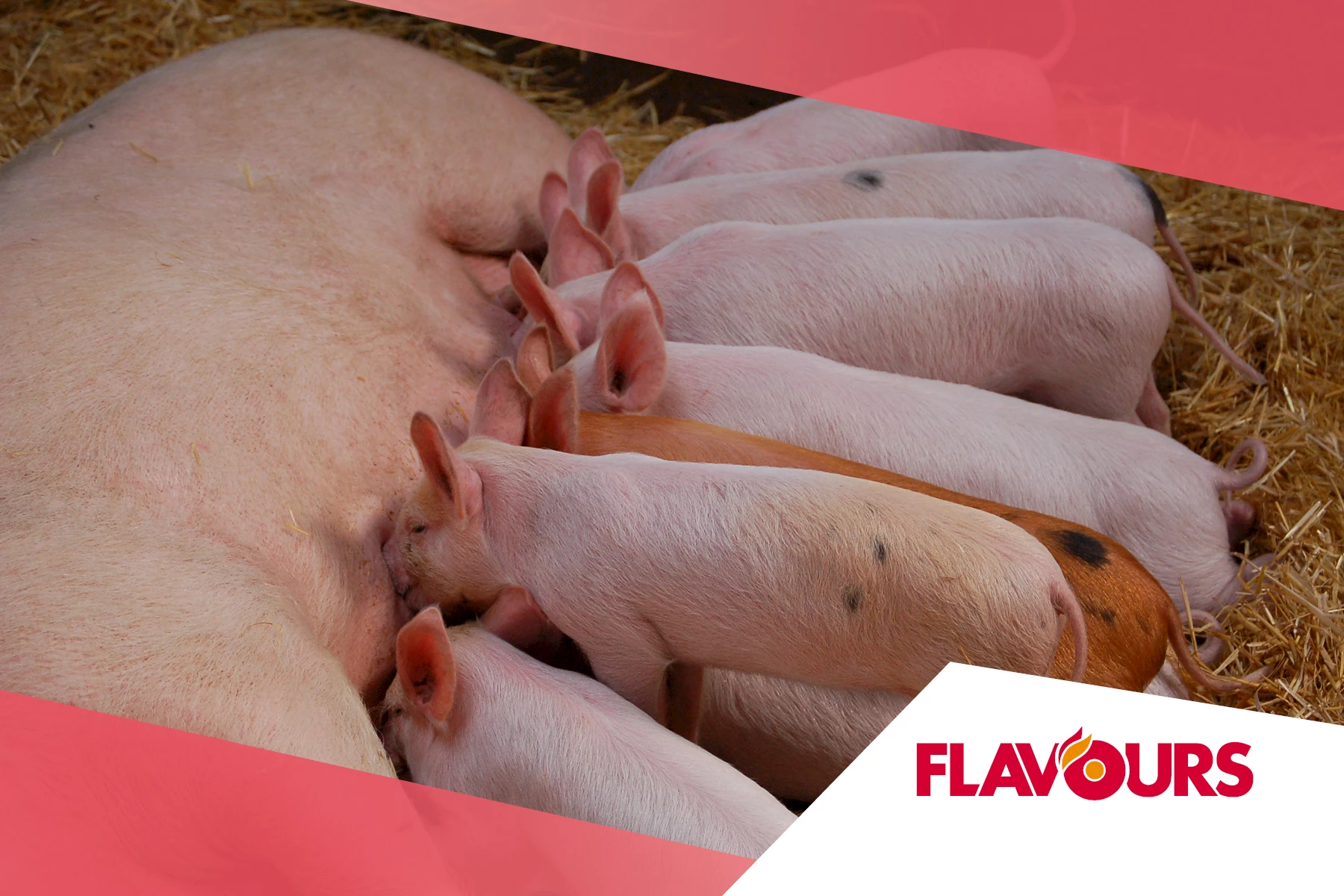
Maternale Aroma-Prägung beschreibt den Prozess, bei dem Aromastoffe aus der Nahrung der Sau während Trächtigkeit und Laktationsperiode an die Nachkommen weitergegeben werden. Diese Stoffe gelangen vor der Geburt über das Fruchtwasser und nach der Geburt über die Milch zu den Ferkeln, wodurch eine frühe und wiederholte sensorische Prägung entsteht.
Forschungen, darunter Studien von Oostindjer et al. (2009, 2010, 2011), haben gezeigt, dass Ferkel diese maternalen Aromastoffe wahrnehmen und wiedererkennen können. Diese frühe Prägung führt zur Bildung eines Aroma-Gedächtnisses, das die Vorlieben und Futterakzeptanz der Ferkel nach der Geburt beeinflusst.
Werden dieselben oder ähnliche Aromen auch in der Ferkelration nach dem Absetzen eingesetzt, erkennen die Tiere das und akzeptieren das Futter besser. Dieser Umstand reduziert Neophobie (Angst vor neuem Futter), steigert die freiwillige Futteraufnahme und erleichtert den Übergang während des Absetzens. Infolgedessen zeigen Ferkel ein verbessertes Wachstum und eine bessere Futterverwertung in der kritischen Phase nach dem Absetzen.
Das Verständnis für die maternalen Aroma-Prägung liefert also wertvolle Einblicke zur Verbesserung von Tierwohl und Produktivität in der Schweineproduktion.
Bigarol® Extarom P kombiniert intensive Waldhonignoten mit einer feinen Vanillenote. Das Aroma ist hochwirksam und bleibt selbst unter den hohen Temperaturen bei der Pelletierung stabil. Ideale Voraussetzungen für den Einsatz in modernen Ferkelrationen.
In der Studie wurde das Aroma sowohl während der Trächtigkeit und der Laktationsphase in die Sauendiät eingebracht und später auch in die Ferkeldiät nach dem Absetzen integriert.
Die Studie wurde in der renommierten Versuchsstation Haus Düsse in Deutschland durchgeführt. Insgesamt wurden 250 Ferkel auf fünf Versuchsgruppen (n = 50) verteilt, untergebracht in Buchten mit jeweils 8 Tieren. Die Dauer des Versuchs betrug 29 Tage, beginnend mit einem durchschnittlichen Körpergewicht von 7,5 kg und endend bei ca. 25 kg. Alle Rationen wurden nach der Aromazugabe pelletiert, um praxisnahe Bedingungen zu simulieren.
Die Versuchsgruppen unterschieden sich hinsichtlich der Aromadosierung sowie der Frage, ob die Sauen während Trächtigkeit und Laktation dem Aroma ausgesetzt waren (maternale Prägung):
Die Ergebnisse verdeutlichen die Vorteile der Aromaanwendung – insbesondere in Kombination mit maternaler Prägung.
Ferkel, die mit Bigarol® Extarom P supplementierte Rationen erhielten, zeigten eine bessere Leistung im Vergleich zur Kontrollgruppe, besonders wenn das Aroma zur maternalen Prägung angewandt wurde.
Durchschnittliche tägliche Futteraufnahme (ADFI):
Die durchschnittliche tägliche Futteraufnahme stieg signifikant in den Gruppen C und E (357 g bzw. 349 g) im Vergleich zur Kontrolle (300 g; p < 0,05). Die höchste Aufnahme wurde in Gruppe C beobachtet, die 200 g/t Aroma mit maternaler Prägung erhielt – ein deutlicher Hinweis auf den Effekt von Vertrautheit und Präferenz. (Abbildung 1)
Durchschnittliche tägliche Zunahme (ADG):
Die tägliche Gewichtszunahme verbesserte sich signifikant in denselben Gruppen C und E (285 g bzw. 278 g) im Vergleich zur Kontrolle (210 g). Auch hier schnitt Gruppe C am besten ab, was die Rolle der frühen Aromenprägung bei der Wachstumssteigerung unterstreicht. (Abbildung 2)
Futterverwertungsverhältnis (FCR):
Das FCR war in den Gruppen C und E (1,25 bzw. 1,26) signifikant besser als in der Kontrollgruppe (1,43), wobei Gruppe C die höchste Effizienz zeigte. (Abbildung 3)
Die Ergebnisse bestätigen, dass die Supplementierung von Aromen die Ferkelleistung verbessert und dass maternale Prägung diese Effekte erheblich verstärkt. Bemerkenswert ist, dass eine höhere Dosierung ohne Prägung (Gruppe D, 400 g/t) weniger wirksam war als die niedrigere Dosierung mit Prägung (Gruppe C). Dies unterstreicht die Bedeutung der frühen sensorischen Prägung gegenüber der reinen Dosierung.



Die Studie mit Bigarol® Extarom P zeigt, dass Aromen mehr sind als ein Futterzusatz – sie sind ein nützliches Werkzeug für Kontinuität, Vertrautheit und Leistung. Maternale Aroma-Prägung erleichtert nicht nur den Absetzprozess, sondern erschließt von Anfang an das volle Potenzial der jungen Ferkel.
Oostindjer, M., Bolhuis, J.E., van den Brand, H. and B. Kemp: 2009: Prenatal Flavor Exposure Affects Flavor Recognition and Stress-Related Behavior of Piglets. Chemical Senses 34: 775-787.
Oostindjer, M., Bolhuis, J.E., van den Brand, H., Roura, E. and B. Kemp: 2010: Prenatal flavor exposure affects growth, health and behavior of newly weaned piglets. Physiology & Behavior 99: 579-586.
Oostindjer, M., Bolhuis, J.E., Simon, K., van den Brand, H. and B. Kemp: 2011: Perinatal Flavour Learning and Adaptation to Being Weaned: All the Pig Needs Is Smell. PLoS ONE 6(10):e25318.

Dr. Anne Winkler: Nach ihrem Diplomabschluss in Agrarwissenschaften absolvierte Anne einen Master in Agrarwissenschaften und Umweltschutz an der Technischen Hochschule in Bingen. 2018 promovierte sie an der Martin-Luther-Universität Halle-Wittenberg im Fach Agrarwissenschaften. Mit diesem fundierten wissenschaftlichen Hintergrund bringt Dr. Anne Winkler nun ihre Expertise als Global Product Managerin für Aromen und Süßstoffe bei Phytobiotics ein.
Kontaktieren Sie unsere Experten oder schicken Sie uns eine Nachricht. Wir melden uns schnellstmöglich bei Ihnen.